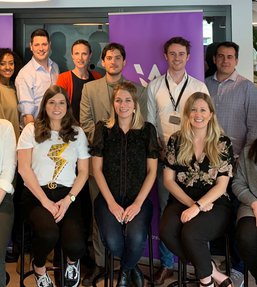
Venture business models deep dive
In ventures, as with all our work, understanding enterprise revenue drivers and success factors is crucial in deciding where repayable finance can drive social impact and the financial returns that attract investors.
- £52.1m Drawn down by venture funds from Big Society Capital – All data from Big Society Capital
- £132m Drawn down by venture funds from Big Society Capital and other investors alongside us
- x1.8 Amount our capital has been matched by other investors in venture
Some examples of revenue and impact models from our portfolio include:
Wagestream
Wagestream lets users access their earned but unpaid wages through affordable lending. Under its revenue model, Wagestream gains customers via businesses (B2B2C) and earns interest on the loans they make. The impact model aligns with this, as they make an impact with each affordable loan they issue (B2B2C). This happens in two ways: firstly, by providing finance to people who would otherwise be unable to access it, and secondly, by generating savings through more affordable forms of finance. You can find out more about Wagestream’s social impact elsewhere in this Impact Report.
Credit Kudos
Credit Kudos has developed an open banking platform that lets lenders access transaction and behavioural data. With this data, they can price loans more accurately, reduce defaults, and accelerate lending, including to those who might otherwise be excluded through other forms of credit checks.

Wagestream
Their revenue comes directly from the lenders they partner with, (B2B) in exchange for access to the platform. The impact model, however, relies on those lenders increasing access to finance and more affordable loans for their customers (B2B2C). You can find out more about Credit Kudos’ social impact elsewhere in this Impact Report.
Second Nature
Second Nature is an evidence-based application that coaches users through behavioural changes that reduce weight and, as a result, the risk of diabetes. Second Nature has two revenue sources. The first is direct-to-consumer sales (B2C), as users pay a monthly subscription fee to access the platform. The second is via the NHS (B2G), as clinicians can refer patients to the platform. The impact model is also direct-to-consumer: for each user who subscribes to the application, their likelihood of developing diabetes is reduced.
The tables below give a flavour of the diversity of business models in our venture portfolio.
| Outcome area | Count | % |
|---|---|---|
| Health (physical and mental) | 20 | 33% |
| Employment, Education and Training | 15 | 25% |
| Income and Financial Inclusion | 13 | 22% |
| Total | 60 | 80% |
| Revenue model | Count | % |
|---|---|---|
| B2C | 19 | 32% |
| B2B | 18 | 30% |
| B2G | 12 | 20% |
| B2B2C | 9 | 15% |
| B2G2C | 1 | 2% |
| Total | 60 | 98% |
Insights
What’s particularly interesting are the dynamics around customers and beneficiaries, and how they interact in a business model. After all, customers are a critical component of the revenue model, and beneficiaries of the impact model.
Here are three insights from our work exploring customers and beneficiaries in impact ventures:
Customers and beneficiaries are not always the same group
For example, DrDoctor, a patient platform that helps hospitals efficiently manage patients, sells to hospitals. But the beneficiaries are the staff and patients who benefit from increased efficiency. Why is this distinction important? Because to create impact and returns, an enterprise needs to offer a product that the customer is willing to pay for and that also makes a meaningful difference in end users’ lives. If we fail to properly recognise either customer or end-user needs, then returns or impact may suffer.
Across our portfolio, and in an estimated 75% of UK startups, an enterprise’s customers and end users are not the same people. This shows how common this dynamic is, and how important it is to manage it well.

Hometouch
Where customers and beneficiaries are closely aligned, impact can drive value
A good example is Credit Kudos, who have developed an Open Banking platform that helps lenders understand risk, particularly in underserved groups. Their customers are lending institutions, but the beneficiaries are borrowers who have access to more/cheaper credit. Here, impact and financial value are aligned. Building a better product for its customers means being able to offer more accurately-priced loans with a lower default rate. For beneficiaries, this translates into more capital available – priced fairly and without the risk of default. So if Credit Kudos increases its impact, it will also improve its financial performance.
Choosing a model that deliberately separates customer and beneficiary can increase scale
Across our portfolio, it appears that B2B and B2B2C revenue models are associated with a broader impact (i.e. numbers of people reached) than other revenue models.

Credit Kudos
We think there are two drivers here. Firstly, in these models a single new customer (i.e. a business) unlocks multiple new end customers. Secondly, in these models end users often don’t pay for the product, which accelerates adoption if a user might otherwise have been unable to afford the product or service. The classic example is a government payer, as is the case with Togetherall and the NHS . There are also cross-subsidy models, where a number of paying users means others with potentially less ability to pay can access freemium content. There are other examples of using innovative dynamics around who is the customer and who is the beneficiary to drive impact and financial returns. For instance, Mush, a platform in our portfolio that lets new, first-time mothers connect and support each other through the challenges of parenthood, has recently introduced a paid option to supplement its free content.